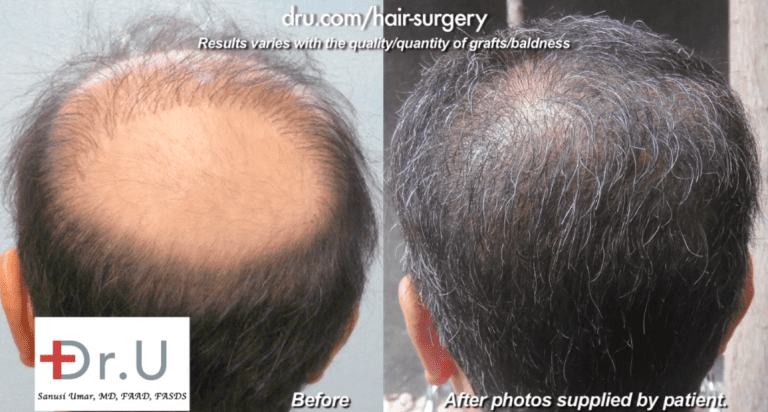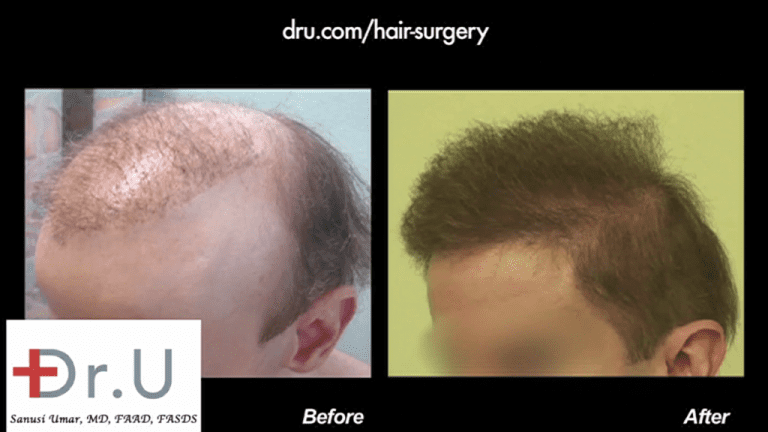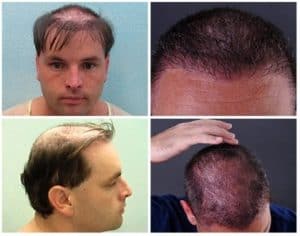Wigs & Hairpieces Post Hair Transplant Surgery: Wigs and hairpieces are often used to cover signs of hair thinning and balding in both men and women. They are also referred to by other terms such as hair systems, toupees, prosthetics, and non-surgical hair replacement. Patients of Dr. U (Dr.Umar), whether they are from Los Angeles or throughout the world, have been using wigs and hairpieces for many years to hide signs of hair loss. Some better debate: getting a hair transplant or wearing a hair replacement wig. Since this practice has been a significant part of their grooming routine, they often wonder if they can continue wearing toupees after their hair restoration surgery.
Article Update August 2022
Although it is typically acceptable to wear a hair piece after hair transplant surgery, certain materials are recommended, as well as other materials that are not recommended – more information on this is detailed below.
On the other hand, these are some of the things you should avoid after hair transplant surgery:
- Swimming
- Drinking Alcohol
- Smoking
- High-Impact Excersise
Can I Wear a Hair Piece After Hair Transplant Surgery?
In this Q&A video, Dr. U addresses the desire of patients to continue relying on wigs and hair systems after their operation. His advice is that it is best to abandon the use of hair prosthetics and explain why this is the best course of action.
How do the use of hairpieces and toupees affect my hair transplant surgery?
After a hair restoration procedure, growth will take some time to develop. In the meantime, is it a good idea for patients to use hairpieces and toupees to c…
Types of Wigs and Hairpieces Used by Hair Loss Sufferers
When people lose their hair, they feel very self-conscious about the regions of baldness or sparseness on the scalp.

An easy solution to resort to is to adopt the practice of wearing wigs [1] and hairpieces [2]. This offers immediate gratification for those who are not yet ready or willing to undergo hair transplant surgery.
Wigs and hairpieces are made of synthetic or natural human hair. Today’s hair system products are often classified by the base used. These include two general categories.
- Mesh
- Polymer
Some hairpiece products use a combination of both.
Wigs and Hairpieces With a Mesh Base
The mesh itself is usually made of polyester or nylon to create a thin layer that appears more natural, especially for the hairline region.
The main benefit of having a mesh base is that it is lightweight and more relaxed. However, it does wear faster due to acids released from the skin.
In some hairpiece products, the mesh is only used for the underside of the hairline portion. In others, the entire base is constructed of mesh.
Hairpiece Systems With a Polymer Base
To avoid slipping, other types of wigs and hairpieces are constructed with a polymer base made of silicone or polyurethane. This type of material offers more durability, tends to last longer, and is less expensive.
On the downside, rubber-like bases can appear unnatural and trap more heat.
These types of wigs and hairpieces should not be worn after a hair transplant. According to Dr.U, the added weight of the polymer base will shift the angles of the inserted grafts, which will undermine the appearance of the outcome.
Methods of Adhering to Wigs and Hairpieces
Wigs and hairpieces are also classified by how they adhere to the scalp. These include:
- Semi-permanent hairpieces (non-surgical hair replacement)
- Temporary adhesive-attached hairpieces
- Clip-on hairpieces
Many of Dr. U’s patients utilized one of these three methods before their hair transplant procedure, including those who needed to repair last hair restoration surgical mistakes.
How Does Non-Surgical Hair Replacement Work?
Some wigs and hairpieces are affixed to the scalp using semi-permanent techniques that involve liquid adhesives such as polyfuse or natural bond. This method is also referred to as non-surgical hair replacement. The hair prosthesis is not meant to be removed by the wearer but by stylists or hair technicians. This is usually done every five to six weeks to remove accumulated dead skin cells, flakes, shed hair, and other forms of debris.
Any glue should not be used after a hair transplant surgery.

Hairpieces with Temporary Adhesive
These wigs and hairpieces use double-sided tape to stay on the scalp. Wearers can reattach the tape themselves. However, this can leave a residue on the skin.
Dr. U recommends stopping double-sided tape for wigs and hairpieces after a hair transplant.
Clip-On Hair Pieces
Wigs and hairpieces with a base made entirely of mesh can be safely worn using clips after a hair transplant procedure. This is only advised in cases where the patient must attend an important social event. The clips on the underside would attach to the surrounding margins of hair.
Following surgery, Dr. U advises that clip-on wigs and hairpieces be worn for about 12 hours daily. Patients should immediately remove their hairpieces when they arrive home.

What Happens If You Continue Wearing Wigs and Hairpieces After Surgery?
As mentioned earlier, many of Dr. U’s patients are used to wearing wigs and hairpieces. They often wonder if continuing this practice after their hair transplant surgery is possible.
According to Dr. U, the occlusive effect of the base can damage the grafts and growth yield. The weight and pressure of a rubber base can change the graft angulation. Glues and tape adhesive can stick to the shaved hair shafts and shift these angles. Furthermore, the wounds created during surgery provide vulnerable openings in the skin. And these types of chemicals can irritate. Sweating and moisture due to tapes, rubber surfaces, or glue will encourage bacterial growth, which is likely to cause inflammation and inflict irreversible damage to the newly inserted follicles.
How to Conceal Signs of Surgery After a Hair Transplant
After a hair transplant procedure, it usually takes about three to four months before seeing the first signs of growth. Around the sixth to the nine-month point, many people can start grooming their hair. But this will differ for individual patients on a case-by-case basis.
A significant concern for many patients is seeing obvious signs of surgery following their operation. Dr. U recommends using loose hats, baseball caps, or beanies after hair transplantation. These head coverings will not press tightly against the scalp’s surface and cause harm to the grafts.
Schedule a Free Consultation with Dr. U Now
For more information regarding hair transplantation, use the button below for a free consultation with Dr. Umar.
Frequently Asked Questions on Wigs and Hairpieces
What is the difference between a hair transplant and hair restoration? Do wigs and hairpieces fall under the category of hair restoration?
Hair transplant refers to the surgical process of extracting hair follicles and transplanting them to bald or thinning areas of the scalp. It is considered one approach to hair restoration concerned with the restoration of hair in general.
While surgery is one way to restore hair, other means include using drugs or medications that may include synthetic or natural chemical compounds. The use of wigs and hairpieces helps to mimic approximate the appearance of a restored head of hair. But this practice is technically not a natural hair restoration treatment.
Is non-surgical hair replacement worth it?
Non-surgical hair replacement uses liquid adhesive to affix a hairpiece unit to the scalp. In the long term, this hair care method is quite time-consuming. It involves having a technician apply the base portion to the scalp. It must also be removed by a specialist periodically to clean up flakes and debris accumulated. The overall system can be uncomfortable for the wearer in hot temperatures as they sweat. It may not be utterly foolproof as the position of the hairpiece may shift in wet conditions, like when it rains or if the person wants to go swimming. Although it creates the look of a full head of hair, the wearer can still feel a sense of inauthenticity about using non-surgical hair replacement systems.
Instead of wearing wigs and hairpieces, is it okay to use hair concealers after my hair transplant?
Hair concealer products contain tiny particles made of synthetic chemicals. After a hair transplant, when your wounds have not entirely closed, these particles can enter the skin and cause irritation and inflammation. It takes about 7 to 10 days for the wounds to close.
Most doctors recommend waiting for the skin to heal before resuming personal hair grooming products. Although there are standard timeframes for average cases, it is best to speak to your doctor about when it would be safe to start using powdered concealers. As long as the skin has healed sufficiently, they would be less risky to the grafts than wigs and hairpieces, which can alter the angles of the inserted hair follicles.
Do you still have questions about using wigs and hairpieces after a hair transplant? Submit them to Dr. U directly by using the button below:
Further Reading
Meet a patient who could finally toss his toupee after his Dr.UGraft™ body hair-to-head transplant.
References
- “Wig.” Wikipedia, Wikimedia Foundation, 2 Nov. 2019, en.wikipedia.org/wiki/Wig.
- “Toupée.” Wikipedia, Wikimedia Foundation, 26 June 2022, en.wikipedia.org/wiki/Toup%C3%A9e. Accessed 3 Aug. 2022.


